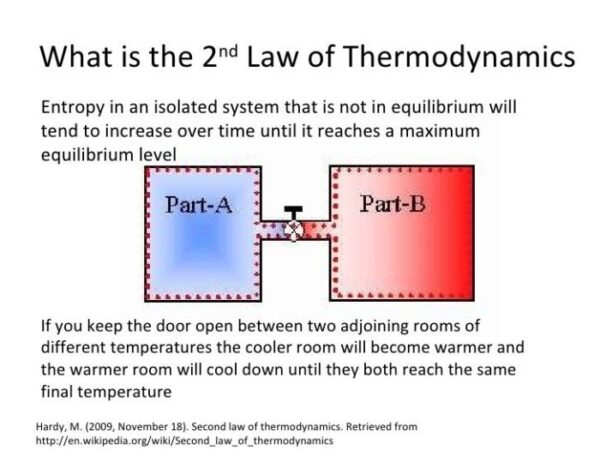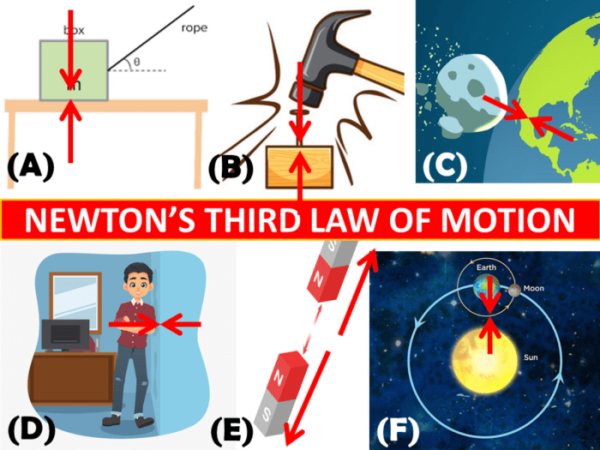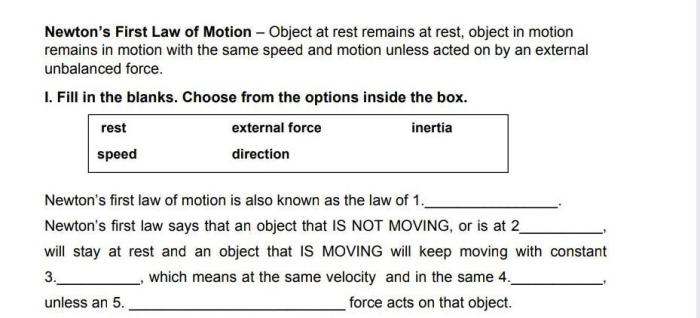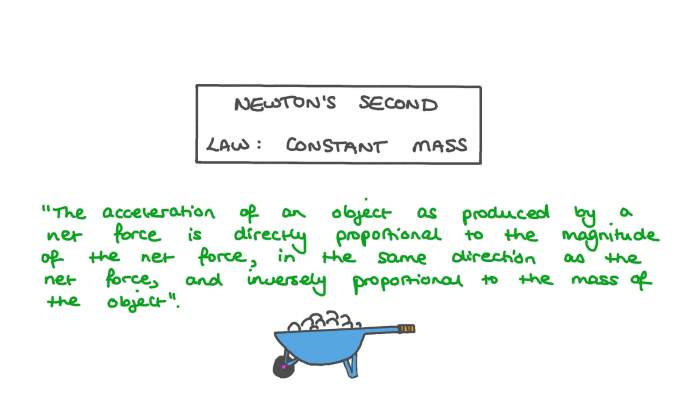
What is the third law of motion? This fundamental law of physics, discovered by Sir Isaac Newton, governs the interactions between objects and explains the concept of equal and opposite forces. It is a foundational principle that governs everything from walking to launching rockets, and understanding it unlocks a deeper appreciation for the world around us.
Newton’s Third Law states that for every action, there is an equal and opposite reaction. This means that whenever one object exerts a force on another object, the second object exerts an equal and opposite force back on the first. This principle is evident in everyday scenarios, like walking, swimming, and even the recoil of a gun.
Introduction to Newton’s Third Law of Motion

Newton’s Third Law of Motion, a fundamental principle in physics, describes the interaction between objects when forces are applied. It states that for every action, there is an equal and opposite reaction. This means that when one object exerts a force on another object, the second object exerts an equal and opposite force back on the first object.
This law is essential for understanding how objects move and interact in the world around us. It explains why we can walk, why rockets launch into space, and why cars can move.
Examples of Newton’s Third Law in Action
The principle of action and reaction is evident in numerous everyday scenarios:
* Walking: When you walk, your foot pushes backward against the ground (action). The ground, in turn, pushes forward on your foot (reaction), propelling you forward.
* Swimming: As you push water backward with your arms and legs (action), the water pushes you forward (reaction).
* Jumping: When you jump, you push down on the ground (action). The ground, in response, pushes you upward (reaction), allowing you to jump.
* Rockets: Rockets work by expelling hot gases downward (action). The expelled gases push back on the rocket (reaction), propelling it upward.
Isaac Newton’s Contributions to Physics
Sir Isaac Newton (1643-1727) was an English physicist, mathematician, astronomer, alchemist, and theologian. His groundbreaking work, *Philosophiæ Naturalis Principia Mathematica* (Mathematical Principles of Natural Philosophy), published in 1687, laid the foundation for classical mechanics. In this work, Newton formulated his three laws of motion and the law of universal gravitation, which revolutionized our understanding of the universe.
Newton’s laws of motion are fundamental to understanding the behavior of objects in motion. They are essential tools for engineers, physicists, and other scientists in their work. His contributions to science continue to shape our understanding of the world around us.
The Statement of the Third Law

Newton’s Third Law of Motion, often stated as “for every action, there is an equal and opposite reaction,” is a fundamental principle in physics that describes the interaction between objects. It helps us understand how forces work and how objects move in response to these forces.
The Meaning of “Action and Reaction”
The statement “for every action, there is an equal and opposite reaction” might seem simple, but it encapsulates a complex concept. Here’s a breakdown:
- Action: The “action” refers to a force exerted by one object on another. It can be any type of force, such as pushing, pulling, or gravitational attraction.
- Reaction: The “reaction” is the equal and opposite force exerted by the second object back on the first object. It’s important to note that the reaction force is always equal in magnitude to the action force but acts in the opposite direction.
“To every action there is always opposed an equal reaction: or the mutual actions of two bodies upon each other are always equal, and directed to contrary parts.” – Isaac Newton, *Philosophiæ Naturalis Principia Mathematica*
Applications of the Third Law
Newton’s Third Law of Motion is not just a theoretical concept; it has far-reaching applications in our everyday lives. From simple activities like walking to complex feats like launching rockets, the principle of action and reaction governs a wide range of phenomena.
Examples of the Third Law in Action
Understanding the interplay between action and reaction forces is crucial for appreciating the mechanics behind various events. Here are some examples that illustrate the Third Law in action:
| Action | Reaction | Description |
|---|---|---|
| A person pushes against the ground with their foot. | The ground pushes back on the person’s foot. | This action-reaction pair allows the person to propel themselves forward. The force exerted by the foot on the ground is equal in magnitude and opposite in direction to the force exerted by the ground on the foot. |
| A swimmer pushes water backward with their arms and legs. | The water pushes forward on the swimmer. | This action-reaction pair propels the swimmer through the water. The force exerted by the swimmer on the water is equal in magnitude and opposite in direction to the force exerted by the water on the swimmer. |
| A rocket expels hot gases downward. | The gases push upward on the rocket. | This action-reaction pair launches the rocket into space. The force exerted by the rocket on the gases is equal in magnitude and opposite in direction to the force exerted by the gases on the rocket. |
Everyday Examples
The Third Law is evident in numerous everyday occurrences. Here are some examples:
- Walking: When you walk, you push your foot backward against the ground. The ground, in turn, pushes forward on your foot, propelling you forward. The force you exert on the ground is equal in magnitude and opposite in direction to the force the ground exerts on you.
- Swimming: As you swim, you push water backward with your arms and legs. The water, in response, pushes you forward. The force you exert on the water is equal in magnitude and opposite in direction to the force the water exerts on you.
- Jumping: When you jump, you push down on the ground with your feet. The ground, in response, pushes upward on your feet, launching you into the air. The force you exert on the ground is equal in magnitude and opposite in direction to the force the ground exerts on you.
- Launching a Rocket: Rockets work by expelling hot gases downward. These gases, in turn, push upward on the rocket, propelling it into space. The force the rocket exerts on the gases is equal in magnitude and opposite in direction to the force the gases exert on the rocket.
Understanding the Third Law in Depth
The Third Law of Motion provides a fundamental understanding of how forces interact within a system. To delve deeper into its implications, we need to explore concepts like momentum and its conservation.
Momentum and its Relation to the Third Law
Momentum is a measure of an object’s mass in motion. It is calculated by multiplying an object’s mass by its velocity.
Momentum (p) = mass (m) × velocity (v)
The Third Law directly influences momentum by stating that for every action, there is an equal and opposite reaction. This means that when two objects interact, they exert equal and opposite forces on each other, leading to changes in their momentum. The total momentum of the system, however, remains constant.
Conservation of Momentum and its Connection to the Third Law
The principle of conservation of momentum states that the total momentum of a closed system remains constant, even if forces act within the system. This means that the total momentum before an interaction is equal to the total momentum after the interaction.
Total momentum before interaction = Total momentum after interaction
This principle is a direct consequence of Newton’s Third Law. When two objects collide, they exert equal and opposite forces on each other. These forces act for the same amount of time, resulting in equal and opposite changes in momentum. The positive change in momentum of one object is canceled out by the negative change in momentum of the other object, maintaining the total momentum of the system.
The Third Law in Collisions
Collisions between objects provide a clear example of the Third Law in action. When two objects collide, they exert equal and opposite forces on each other. These forces cause changes in their velocities, and consequently, their momenta. However, the total momentum of the system remains constant.
For instance, consider a car colliding with a stationary truck. The car exerts a force on the truck, causing the truck to move forward. At the same time, the truck exerts an equal and opposite force on the car, causing the car to slow down or even change direction. The total momentum of the car and truck system before the collision is equal to the total momentum after the collision.
Misconceptions and Clarifications
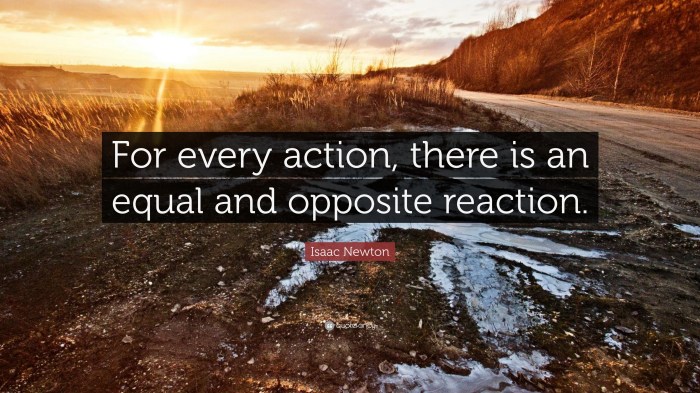
Newton’s Third Law of Motion, while seemingly straightforward, often leads to misunderstandings. It’s crucial to address these misconceptions to gain a clear understanding of the law’s implications.
Common Misconceptions, What is the third law of motion
Many common misconceptions arise from misinterpreting the Third Law’s statement. The following points clarify these misunderstandings:
- Equal and opposite forces act on the same object: This is incorrect. The Third Law states that forces always occur in pairs, acting on *different* objects. For example, when you push a wall, the wall pushes back on you with an equal and opposite force. The forces act on you and the wall, not on the same object.
- The Third Law implies that objects always remain at rest: This misconception arises from the idea that if forces always come in pairs, they should cancel each other out, leading to no motion. However, the Third Law doesn’t dictate the overall motion of an object. It simply describes the interaction between two objects. For example, a rocket’s engines push hot gases out, and the gases push back on the rocket, propelling it forward.
- The Third Law only applies to contact forces: While the Third Law is often illustrated with contact forces (like pushing a wall), it applies to all types of forces, including gravitational forces. For example, the Earth exerts a gravitational force on the Moon, and the Moon exerts an equal and opposite gravitational force on the Earth.
Comparing and Contrasting the Third Law
The Third Law is distinct from the other laws of motion:
- First Law (Inertia): The First Law describes an object’s tendency to resist changes in its motion. It focuses on the state of motion of a single object. In contrast, the Third Law describes the interaction between two objects.
- Second Law (F=ma): The Second Law relates the net force acting on an object to its mass and acceleration. It focuses on the relationship between force, mass, and acceleration for a single object. The Third Law, however, focuses on the interaction between two objects, regardless of their individual motion.
The Third Law in Action
The third law of motion is often called the “action-reaction” law. It’s a fundamental principle that governs the interactions between objects. To understand it better, let’s delve into some real-world examples.
Visualizing the Third Law
A simple illustration can help visualize this concept. Imagine two objects, A and B, interacting with each other. When object A exerts a force on object B (action), object B simultaneously exerts an equal and opposite force on object A (reaction). These forces are always equal in magnitude and opposite in direction.
Forces Involved in Jumping on a Trampoline
Let’s consider the example of a person jumping on a trampoline. When a person jumps, they exert a downward force on the trampoline (action). In response, the trampoline exerts an upward force on the person (reaction). This upward force propels the person back into the air.
Action, Reaction, and Motion
We can summarize the forces involved in this example using a table:
| Action | Reaction | Resulting Motion |
|—|—|—|
| Person exerts a downward force on the trampoline | Trampoline exerts an upward force on the person | Person is propelled upwards |
The person’s downward force on the trampoline is the action, and the trampoline’s upward force on the person is the reaction. These forces are equal in magnitude and opposite in direction, leading to the person being propelled upwards.
Ultimate Conclusion: What Is The Third Law Of Motion
Understanding Newton’s Third Law of Motion is essential for comprehending the mechanics of the universe. It provides a framework for understanding how forces interact and influence motion. By exploring the concept of momentum and the conservation of momentum, we gain a deeper appreciation for the interconnectedness of all physical phenomena. The Third Law is a testament to the elegance and simplicity of the laws of nature, demonstrating that for every action, there is a predictable and measurable reaction.
Query Resolution
Does the Third Law apply to all forces?
Yes, the Third Law applies to all forces, regardless of their type. This includes gravitational forces, electromagnetic forces, and even the weak and strong nuclear forces.
Can the Third Law be used to explain why objects fall to the ground?
While the Third Law is not directly responsible for gravity, it plays a role in the interaction between objects. When an object falls, it exerts a force on the Earth, and the Earth exerts an equal and opposite force back on the object, causing it to accelerate towards the ground.
What is the difference between the Third Law and the Law of Conservation of Momentum?
The Law of Conservation of Momentum is a direct consequence of the Third Law. It states that the total momentum of a closed system remains constant. The Third Law explains why momentum is conserved, as the equal and opposite forces acting on objects result in a net change in momentum of zero.
